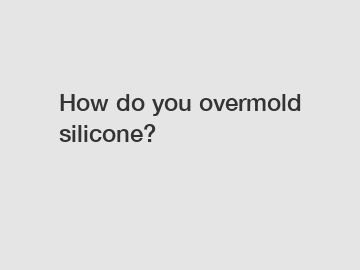How do you overmold silicone?
Overmolding silicone is a common manufacturing process that involves using two or more materials to create a finished product. In this article, we will explore how silicone is overmolded and its significance and impact in the manufacturing industry.
To begin with, overmolding silicone is achieved by injecting or transferring liquid silicone rubber (LSR) onto a preformed or partially formed substrate. The substrate can be made of various materials such as plastic, metal, or even another silicone component. The silicone material is then cured or vulcanized, resulting in a seamless and durable bond between the two materials.
The process of overmolding silicone has several advantages. Firstly, it allows for the creation of complex and intricate designs that would be difficult or impossible to achieve with a single material. This opens up new possibilities for the design and functionality of products. Secondly, the overmolded silicone provides improved ergonomics and tactile feel, making the final product more comfortable to use. Additionally, the silicone layer can enhance the product's durability and resistance to environmental factors such as moisture, chemicals, and UV radiation.

The overmolding process begins with the selection of the appropriate materials for the substrate and the silicone. It is important to consider factors such as compatibility, adhesion properties, and mechanical requirements. The substrate material should have good adhesion properties to ensure a strong bond with the silicone. Surface preparation techniques, such as cleaning and priming, are often employed to enhance adhesion.
Next, the silicone material is prepared by mixing and degassing the liquid silicone rubber. This ensures uniformity and helps eliminate any trapped air bubbles that can affect the final product's quality. The silicone is then injected or transferred onto the substrate using specialized equipment, such as injection molding machines or transfer molding presses.
Once the overmolded parts are formed, they are subjected to a curing process. This typically involves heating the entire assembly to a specific temperature and holding it for a predetermined amount of time. The curing process allows the silicone to crosslink and bond with the substrate material, resulting in a strong and durable overmolded part.
The ability to overmold silicone has revolutionized the manufacturing industry. It has enabled the production of innovative and advanced products that combine the benefits of different materials. For example, overmolding silicone onto a plastic substrate can provide the flexibility and softness of silicone while retaining the structural strength and rigidity of the plastic. This versatility has found applications in various industries, including automotive, electronics, healthcare, and consumer goods.
In conclusion, overmolding silicone is a complex yet essential process in the manufacturing industry. It allows for the creation of unique and advanced products by combining different materials. The process involves careful material selection, surface preparation, and curing techniques. The resulting overmolded parts exhibit improved functionality, durability, and aesthetics. With its wide range of applications, overmolding silicone continues to shape and enhance various industries, driving innovation and improving the end-user experience.
The company is the world’s best dispensing closure, dispensing closure, dispensing closure supplier. We are your one-stop shop for all needs. Our staff are highly-specialized and will help you find the product you need.

Comments